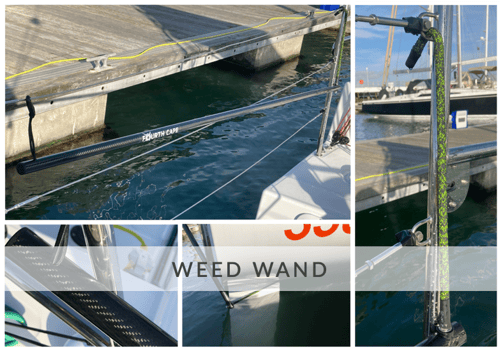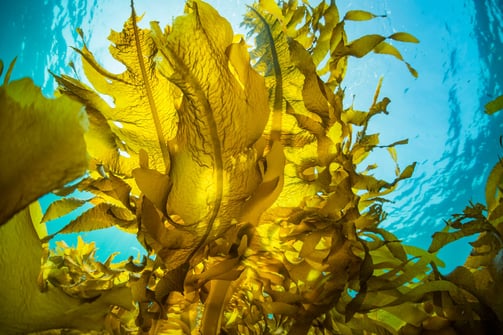
Credit - FourthCape
Rudders are prone to catching seaweed, particularly when there are 2 of them! Dragging weed will slow down any boat but is especially problematic for racing yachts. Therefore it's important to check regularly and have a reliable method for removing anything that snags. The FourthCape WeedWand is a simple and effective tool for clearing the rudders and features a lightweight carbon construction.
Weed
Let’s start by picturing a scene many of us are familiar with.
It’s a dark night and you are just back on deck having been down to look at the Nav. The autopilot is doing a better job of steering through the darkness than you could, so you took the opportunity to make a brew and download the latest weather. On deck you soon become aware that something is not right: the boat feels sluggish or sticky in the water. The numbers confirm that you are slightly down on speed and a feeling of anxiety creeps in. How long have you been slow without noticing? You start to tear your hair out going round in circles, tweaking the jib, re-trimming the main. But no matter what you try, that dreamy mode of balance and speed seems just beyond your fingertips and you begin to question everything you know about sail trim. A tell-tale vibration felt through the helm is often the first indication that your woes may be due to aquatic vegetation rather than lack of skill or that knackered jib. A torch beam over the stern confirms the suspicion as you see a long tail of kelp streaming behind the boat. A quick sigh of relief – maybe the new jib can wait another year after all! But dragging weed through the water is not a good look, so you re-engage the autopilot and get to work.

The issue of weed snagging on appendages must be as old as sailing itself, but two key changes in yacht design have led to the proliferation of this problem:
- First is the move away from long keel hulls to the now widely adopted fin and spade rudder configuration which provides plenty of near-vertical leading edge on which weed can become lodged
- Secondly, the modern trend for twin rudders among offshore boats further exaggerates this, but can also provide part of the solution as we discuss later
Sailors have employed many tactics for weed removal over the years, the simplest being to jump in the water and remove the offending foliage by hand. Other solutions include flossing lines and any number of DIY weed sticks. Professional racing programmes with a dedicated boat captain might be found sporting a custom weed stick built from carbon or glass fibre and profiled to match the shape of the hull. Others opt for whatever they can get their hands on, be it a boat hook, a broomstick or the top section of a windsurf mast. Although perhaps cost effective, most of these solutions are unsatisfactory and don’t do justice to the time and money spent achieving a silky smooth hull finish. Enter FourthCape and the WeedWand.
FourthCape
FourthCape is a sports management company at heart, specialising in the sphere of sailing. Like many sailing businesses there is a very personal story behind it. The company was founded in 2016 by Charles Darbyshire whose expertise derives from a diverse career in the industry. Since working with Ellen Macarthur on her record breaking trimaran, Charles and his team have been involved with numerous sailing success stories including Dong Feng Race Team in the Volvo Ocean Race and running the Artemis Offshore Academy in the UK. Having sailed around the 3 great capes (Cape Leeuwin, Cape Horn and The Cape of Good Hope), for Charles this represents his 4th significant landmark: FourthCape.
During the time FourthCape spent working with Figaro 2s, weed removal by jumping overboard was a regular practice for the solo sailors. Weed is particularly abundant around the north west coast of France and removing it from appendages is simply a necessity if you are racing.
WeedWand
While double rudders tend to catch more weed than a single rudder, they also lend themselves to a simple but elegant solution. Due to the fact they are typically mounted closer to the transom, twin rudders offer the opportunity for a standardised weed removal device. The WeedWand is just that! The lightweight construction consists of a carbon fibre tube with a stainless steel hook fitted at 90 degrees forming an L-shape. The stainless hook is covered with a Polyester braided jacket to protect the rudders.

How to use the Weedwand

Credit - FourthCape
Using the WeedWand involves 3 steps:
- Lower off the transom and hook onto the top of the rudder above any weed
- Push weed down the rudder
- Continue all the way off the bottom of the rudder and watch the weed float free. Be sure to keep a hold of the WeedWand
This simple but effective product is assembled to an exacting standard by hand in Cowes on the Isle of Wight. The WeedWand is not just a weed stick, it’s also a beautiful piece of carbon that any boat owner would be proud to hang on their guard rail.
The standard size has been tested on the following boats but will work on any vessel of a similar size with rudders in a similar position:
- Sunfast 3200, 3300, 3600
- JPK1010, 1030, 1080
- Figaro 2, Figaro 3
Summary
- Weed catching on underwater appendages is common, especially for twin rudder boats
- Dragging anything through the water is slow, be it weed, a fishing net or a spinnaker
- Regularly checking for weed is important, particularly at night when you might easily sail across a weed patch that couldn’t be seen
- Weed removal doesn’t have to involve going for a swim if you have a simple and effective tool like the WeedWand
If you have any questions about the Fourthcape weedwand, please feel free to email us at support@upffront.com, or click the link below to see our full range:



